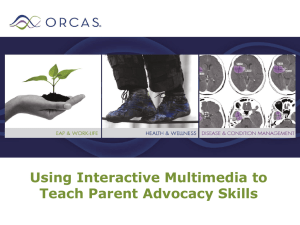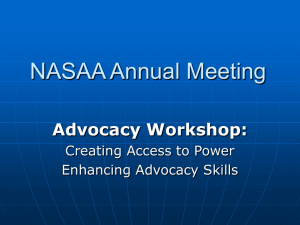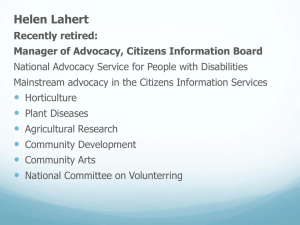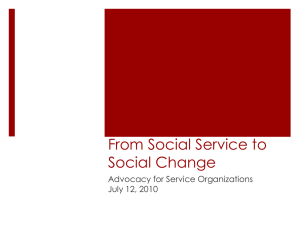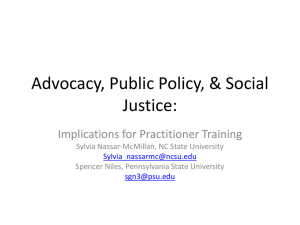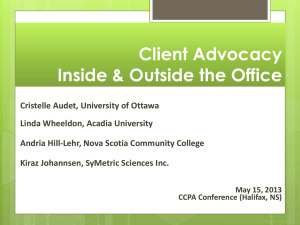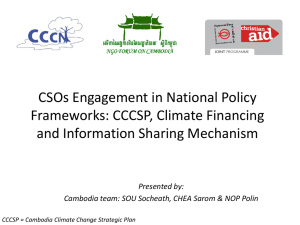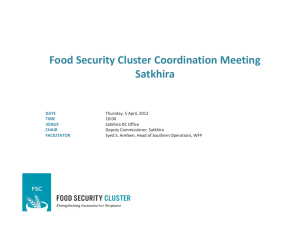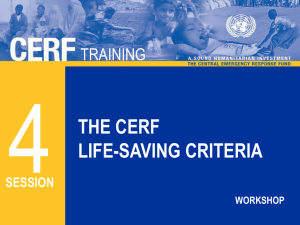3.1 Advocacy and Resource Mobilisation
advertisement
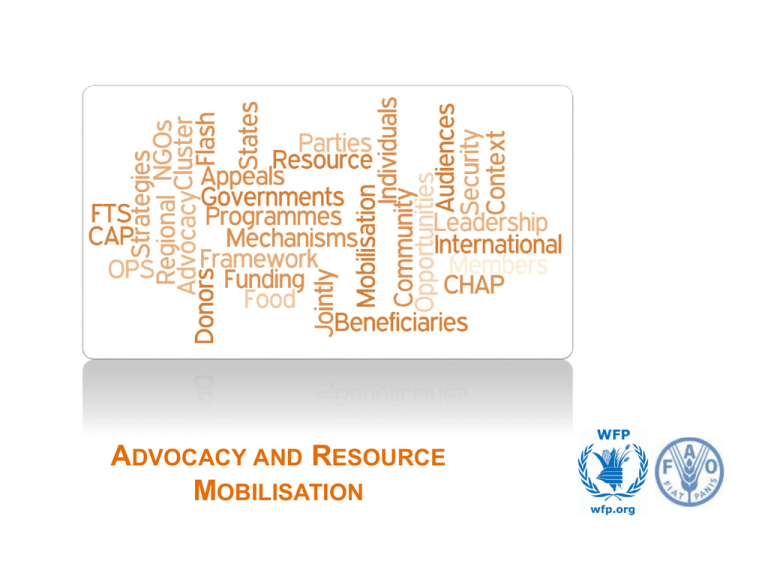
ADVOCACY AND RESOURCE MOBILISATION ADVOCACY AND RESOURCE MOBILISATION INTRODUCTION 1. Objectives 2. Advocacy 3. Resource Mobilisation 4. Funding Mechanisms Advocacy and Resource Mobilisation 2 ADVOCACY AND RESOURCE MOBILISATION OBJECTIVES 1. Understand FSC cluster/cluster lead role in humanitarian advocacy 2. Discuss common opportunities and challenges related to funding mechanisms and donor relations 3. Identify potential resources linking funding to strategies & programmes and the various appeal processes. 4. Understand how to coordinate and lead joint funding efforts and donor relations within a cluster framework Advocacy and Resource Mobilisation 3 ADVOCACY AND RESOURCE MOBILIZATION RELEVANCE Why is this subject covered? The FSC is charged with advocating for and promoting food security needs and focus points on behalf of the entire food security community. It also has a responsibility of mobilizing resources and funding on behalf of the overall food security response. How does this relate to my day to day tasks? Cluster staff help coordinate partners in the formation of a coherent advocacy message and communication plan. They also coordinate the development and execution of the food security sector portions of traditional and non-traditional funding mechanisms. Advocacy and Resource Mobilization 4 ADVOCACY – WHAT IS IT? What? Making a persuasive argument for a specific outcome The active promotion of a cause or principle • • • • • • Objective Stakeholder Funding Access Protection Attention Giving Voice Rights • Donors • Government • Affected population • HC • Other clusters Strategy • • • • • • Public/Private Evidence-base Sector bulletin News media Strategy docs Funding mech. What is needed? • All stakeholders aware of situation, risks, needs, and opportunities in the FS sector. • Affected population aware of risks and measures to reduce vulnerability and accelerate recovery. 5 Building an Advocacy Strategy Step 1: Step 2: Step 3: Step 4: Step 5: Step 6: Identify and clarify the issue Establish goals and objectives Define target audiences and stakeholders Select messages and tactics Developing an action plan Monitoring and evaluation From: IASC Cluster Leadership Training FOOD SECURITY CLUSTER- TOR Guidance for Coordination Actions Coordinated What does the FSC do? 1. Ensure predictable and accountable leadership 2. Represent the food security community in the different country level fora 3. Support coordination in assessment planning and response, strategy 4. Develop benchmarks and indicators 5. Advocacy for entire food security community, not just specific partners 6. Strengthen national/local systems 7. Ensure quality of response, promotion of appropriate standards and delivery of services 8. Ensure shared understanding of early recovery 9. Learn and build upon best practices 10. Ensure partnership and inclusiveness Programmatic Response 7 Why? ADVOCACY – WHY AND HOW Accountability and predictable leadership Efficiency and effectiveness Advocacy for entire food security community How? • • • • • Partnership/ inclusiveness Identify key partners and strengths Establish advocacy working group Agree objectives and strategy Ensure all partners can understand Invite donors to meetings, assessments Represent the food security community • Highlight needs in all relevant multi-sectoral fora • Participate in multi-sectoral advocacy strategies • Establish awareness with other sectors Strengthen national/local systems • Consider local contexts; public/private fora • Ensure materials are understandable and adapted Ensure quality of response Ensure shared understanding of recovery • Agreed standards; mainstream cross cutting issues • Ensure stakeholder awareness of importance and possibility of recovery promotion 8 RESOURCE MOBILIZATION – CLUSTER ROLES Strategy Development Proposal Review & Generation of FS Portion of Appeal M&E Programmatic Response What? FLASH APPEAL – WHAT IS IT? Tool for structuring humanitarian response in first 3 to 6 months Goal is to mobilize resources from donors HC triggers process and defines timeframe for preparation FSC Sector Response Plan • Strategy • Roles and responsibilities • Outlines on prioritized proposed projects 5-7 days after crisis onset 48 hrs later HC OCHAGeneva Consolidates plans Issues Flash Appeal 1 month later Updated Flash Appeal Sends to Geneva What is needed? • Food security inputs to flash appeal are convincing and submitted in time for inclusion in appeal. • FS concerns are reflected in definition of overall inter-sectoral priorities and 11 strategy CENTRAL EMERGENCY RESPONSE FUND – WHAT IS IT? What? • UN Standby fund to enable more timely, reliable, equitable human. assistance • Complements – does not substitute – for flash and consolidated appeals • Rapid response (seed funds) and under-funded emergencies (life-saving) • Intended to support general emergency but only UN agencies can request FSC – CLA (UN) • Produce CERF request in parallel with flash appeal • Select and prioritize from flash projects w/o donor support • Request concise project summaries from agencies; advocate What is needed? HC Approves request Sends to Geneva OCHAGeneva Approves CERF request FSC CLA (UN) • Ensures funds allocated for NGO projects are passed through Food security proposals for CERF funding are convincing and submitted in time for inclusion in the HC’s recommendation for funding 12 CONSOLIDATED APPEAL – WHAT IS IT? What? • A tool to plan, coordinate, implement, and monitor major humanitarian activities • ERC and IASC, in consultation with HC, decide when to use • HC leads development; 1 month to develop; issued 3-6 months after onset FSC Common Humanitarian Action Plan • Priority sector needs and risks • Objectives (5) and Indicators (5) • List of contributing organizations • Outline showing proposed activities and complementarity • Explanation of monitoring • Implications if not implemented HC Consolidates sector portions of CHAP OCHAGeneva Issues Appeal Submits Appeal FSC Mid-year review • • • Incorporate new info Review projects for relevance, feasibility, and economy Prioritize un/underfunded projects What is needed? • Sector elements are convincing and submitted in time for inclusion in appeal • Sector concerns appropriately affected in overall inter-sectoral strategy • Mid-year reviews effectively measure progress and reorient strategies 13 OTHER FUNDING SOURCES Common Humanitarian Funds (CHF) Multiple Donors Trust Fund Community Peace and Stability Fund National Emergency Response Fund (ERF) 14 RESOURCE MOBILIZATION – HOW Establishing Review Procedure • Representative working group with appropriate co-chairs • Review general criteria established by HC • Agree on food security criteria • Transparently communicate procedures, criteria, and decisions to all cluster partners • Principles of Partnership Establishing Review Criteria Sample Criteria for Project Prioritization: • Strategy • Organizational Capacity • Population • Geographic area • Timing • Gender Marker CERF Life-saving Criteria 15 Planning an Advocacy Strategy Scenario: Humanitarian orgs have been running ongoing food assistance programme in northern Insecuristan where drought is now 2 years old. Northern Province Republic of Insecuristan Southern Province Since November’s failed harvest, NGOs have been reporting rising GAM rates throughout much of Southern Province region as well where few humanitarians organisations have traditionally worked. The Food Security Cluster wishes to focus attention on this need. Assessment and Analysis 17 Planning an Advocacy Strategy Task: With your group: Plan a food security cluster advocacy strategy to: alert stakeholders to the growing need in Southern Province, and identify possible funding streams Current Food Security Cluster Members • FAO • WFP • IFRC • ACTED • CARE • LWF • Samaritan’s Purse • World Vision • SCF/UK • ACF Step 1: Identify and clarify the issue Step 2: Establish goals and objectives Step 3: Define target audiences and stakeholders Step 4: Select messages and tactics Step 5: Developing an action plan Step 6: Monitoring and evaluation Northern Province Republic of Insecuristan Southern Province Key aspects of advocacy strategy • Clear buy–in from cluster members • Clear issue(s) & objectives • Clearly defined target audience – in particular, those donors who are likely to show interest • Appropriate messages (in line with selected target audience) • Appropriate tactics, delivery methods Assessment and Analysis 19 ADVOCACY AND RESOURCE MOBILIZATION RELEVANCE Why is this subject covered? The FSC is charged with arguing for and promoting food security needs and focus points on behalf of the entire food security community. It also has the direct responsibility of mobilizing resources and funding on behalf of the overall food security response. How does this relate to my day to day tasks? Cluster staff help coordinate partners in the formation of a coherent advocacy message and communication plan. They also coordinate the development and execution of the food security sector portions of traditional and non-traditional funding mechanisms. Advocacy and Resource Mobilization 20 FOOD SECURITY CLUSTER


